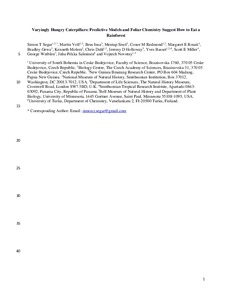Variably hungry caterpillars: predictive models and foliar chemistry suggest how to eat a rainforest
Segar ST; Volf M; Isua B; Sisol M; Redmond CM; Rosati ME; Gewa B; Molem K; Dahl C; Holloway JD; Basset Y; Miller SE; Weiblen GD; Salminen JP; Novotny V
Variably hungry caterpillars: predictive models and foliar chemistry suggest how to eat a rainforest
Segar ST
Volf M
Isua B
Sisol M
Redmond CM
Rosati ME
Gewa B
Molem K
Dahl C
Holloway JD
Basset Y
Miller SE
Weiblen GD
Salminen JP
Novotny V
ROYAL SOC
Julkaisun pysyvä osoite on:
https://urn.fi/URN:NBN:fi-fe2021042717461
https://urn.fi/URN:NBN:fi-fe2021042717461
Tiivistelmä
A long-term goal in evolutionary ecology is to explain the incredible diversity of insect herbivores and patterns of host plant use in speciose groups like tropical Lepidoptera. Here, we used standardized food-web data, multigene phylogenies of both trophic levels and plant chemistry data to model interactions between Lepidoptera larvae (caterpillars) from two lineages (Geometridae and Pyraloidea) and plants in a species-rich lowland rainforest in New Guinea. Model parameters were used to make and test blind predictions for two hectares of an exhaustively sampled forest. For pyraloids, we relied on phylogeny alone and predicted 54% of species-level interactions, translating to 79% of all trophic links for individual insects, by sampling insects from only 15% of local woody plant diversity. The phylogenetic distribution of host-plant associations in polyphagous geometrids was less conserved, reducing accuracy. In a truly quantitative food web, only 40% of pair-wise interactions were described correctly in geometrids. Polyphenol oxidative activity (but not protein precipitation capacity) was important for understanding the occurrence of geometrids (but not pyraloids) across their hosts. When both foliar chemistry and plant phylogeny were included, we predicted geometrid-plant occurrence with 89% concordance. Such models help to test macroevolutionary hypotheses at the community level.
Kokoelmat
- Rinnakkaistallenteet [27094]
